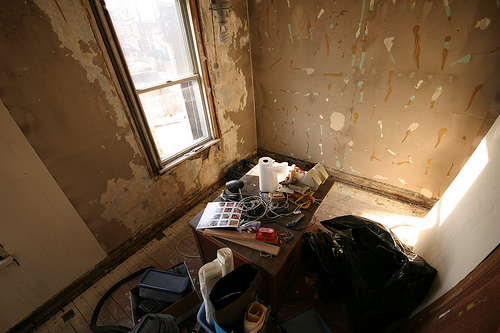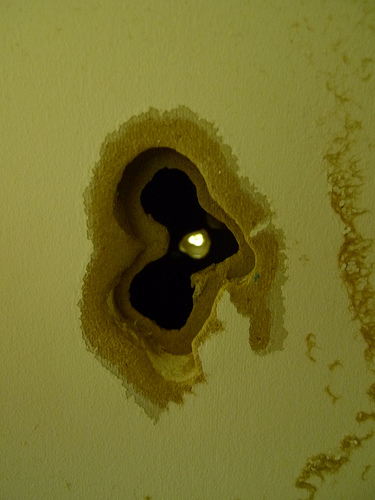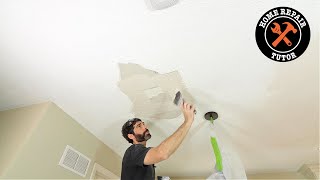[post_name sheetrock repair How to Repair Drywall Or Plasterboard Walls

Repairing cracked drywall joints could be irritating at ideal. If there is just an extremely, really tiny split present, you may have the ability to scratch out the split to a larger dimension then simply use new spackling compound. Utilizing a sharp, sharp tool such as an old fashioned can opener (church trick), scratch placed a groove wider and also somewhat longer compared to the crack. It has to be at the very least 1/8" deep yet much deeper is better. There are covering compounds available today made just for covering fractures yet are not planned for large locations. If this is a repainted wall some quantity sanding will additionally be called for. Spackle will certainly not stay with a smooth painted coating. Sand the area around the fracture a minimum of a number of inches larger than the fracture then proceed and also use the patching compound seeing to it you compel the spackle down into the fracture. Right after applying the spackle, re-wipe the location with your blade to get rid of any kind of excess spackle from the area leaving a level surface. Relying on exactly what type of substance you bought the drying times differ rather a bit from mins to hrs. After the spackle is totally dry usage a 100 or 120 grit drywall fining sand paper to smooth area so it is flush with the existing wall surface. Prime the drywall and also mount the last paint.In a situation
where the splits are a lot bigger along the seams, it may brought on by the drywall tape pulling loose, physical damage or probably even excess dampness. Thoroughly get rid of any and also all loose products at taped areas. You could not and also I repeat, can not re-spackle old tape. The drywall tape has minute holes that enables the spackle to travel through and also anchor the tape to your joints. The spackle "damps" the tape aiding it not just to adhere to the drywall however enables the spackle to form a bond on both sides to the drywall. Once it is made use of, the holes are filled therefore making the tape worthless. Attempting to brief cut will just cause the seam to re-crack later.After eliminating all loose products, lightly sand the damaged areas being cautious not to tear or sand through the paper layer of the drywall underneath. Once the area is smooth to the touch make certain you have actually fined sand uniformly onto the surrounding area so as not to leave an edge that will show via the completed job. Using a six inch broad spackle blade, mount an even layer of brand-new spackle over the seam. Put your brand-new drywall tape over the seam and also using the knife, push the tape strongly onto the drywall getting rid of all excess spackle as it presses out from under the tape as well as sides of the knife. Do not get rid of way too much spackle so as to leave the paper dry. When the location is as smooth as you could make it, use a second lighter layer over the exact same area ensuring the brand-new tape is completely embedded in fresh spackle.After drying out for someday to guarantee all the spackle is dry, re-sand the
whole area to once again acquire a smooth feel to the entire repaired area. Utilizing your twelve inch blade, spread out a second layer to the whole fixing seeing to it you mix smoothly onto the adjoining wall surface surfaces. Do not leave any type of ridges or sharp sides where you satisfy the old wall surface finish.Once this 2nd layer of spackle is completely dry, which will certainly be much less compared to the base coat as it is much thinner, use, using your twelve inch knife, a third very thin layer of fresh spackle. You will certainly almost be able to see via this coat as it is used to fill small indents or scratches left by fining sand the second coat. Once more after the 3rd coat dries out, really gently sand the repair for the last time to ensure a totally smooth finished area. Use a layer of drywall primer to secure the freshly repaired drywall area and afterwards painting your wall.If the drywall seams have actually completely cracked or divided open there may be a structural issue that should be re-mediated before you take care of the drywall seams. Building negotiation, structure problems or other items could effect the drywall finishes so be certain they are fixed first.Once you make certain there are no other problems present, as in a small repair work, remove all loose or broken products. If the drywall itself is broken, reduced the drywall back to a stud as well as mount a new item of drywall. The repair work is the very same as a small crack only on a much bigger scale.Installing little pieces of drywall for patching produces what are called butt joints which are much harder to hide. You will certainly be required to spread your spackle over a much larger location to
get a smooth appearance and also not a bump in the wall surface. With technique you could do this job and also conserve yourself a good deal of money.If you are in a hurry as well as the fixing is relatively small, there fast drying materials available such as Durobond 90 which when included to spackle makes the spackle rock hard in ninety mins. There is also a forty-five minute type available yet just genuine pros must try and use it. Forty-five mins zips truly rapid. When I state it dries out rock hard, it is practically impossible to sand when dried out so any small issues left in the surface with your knife will certainly reveal later. Be careful.Remember to keep your devices tidy, do not pry open coulds or lids with your blades as it will certainly dent or chip the edges of the blades and job as tidy as you could to prevent strenuous clean-up later on.
How to Repair Drywall Or Plasterboard Walls
It is not unusual to discover fractures in a concrete structure of a home. This goes for new houses as well as older ones. While some fractures could suggest a severe problem with the house, many are taken into consideration typical shrinkage cracks. Let's discuss the concern of splits in a foundation and just what it implies to you.Minor shrinking splits prevail in new in addition to older house structures. Poured concrete reduces as it cures, or clears up. As the concrete shrinks, small vertical or 45 degree fractures could develop in time at basement home windows, door openings, or corners. We call these tension or surface area fractures. These cracks are 1/4"wide or less and do not affect the structure of the building. If you see small splits in a brand-new structure, or an old structure for that matter, do not panic. The concern below is moisture intrusion right into the basement or crawlspace. This is a fairly very easy solution with epoxy insertion or concrete caulk. On older houses these splits might return, particularly if the walls are made from lath as well as plaster. Yet, don't be alarmed, it's just the house remaining to settle.The exact same could be true of cracks in the drywall of the house. Stress or working out splits will be tiny in size, regarding a 1/4 inch, and go at a 45 degree angle from the corner of the door framework or window. Once more, don't worry as this is not an architectural issue however more cosmetic. Repair service of the split include quickly executed drywall fixing, which can be achieved in very little time.More serious splits in the foundation or walls do require the interest of a qualified service provider to examine and deal with. The kind of fracture that regards attention is the horizontal fracture. These fractures are commonly come with by bowing, building, or leaning of the structure wall. These sorts of fractures might show a structure issue, which could be pricey to deal with or if it could be corrected.There are also additional types of fractures that could be associated with structural motion. Included in the severe crack classification are cracks that have deflection. By this we mean that a person side of the fracture is greater or beyond the opposite of the fracture. Likewise fractures that run diagonally across a wall surface, or in a staircase step style. As well as last but not least, splits on the indoor finish (drywall or turret as well as plaster )that are in the very same area as fractures on the exterior of the home.Repair of these structural activity or architectural damages splits could consist of numerous different opportunities. Many of them will consist of repair work of the outside as well as to the interior portion of the
home.That in short is a conversation of foundation or wall fractures in a house. If you see these kinds of cracks, it may be best to have a certified expert examine
the cracks. The expert can after that give you a suggestion if they are normal resolving fractures or among a more severe nature.

How to Repair Wet Drywall
Drywall repair Margate - hanging drywall
